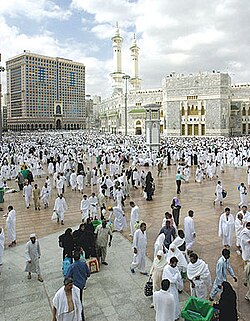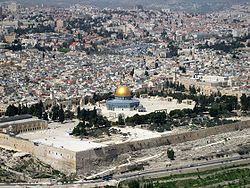Holy city
Holy city | |
|---|---|
| Holy city of Mecca | |
 |
Holy city is a term applied to many cities, all of them central to the history or faith of specific religions. Such cities may also contain at least one headquarters complex (often containing a religious edifice, seminary, shrine, residence of the leading cleric of the religion and/or chambers of the religious leadership's offices) which constitutes a major destination of human traffic, or pilgrimage to the city, especially for major ceremonies and observances. A holy city is a symbolic city, representing attributes beyond its natural characteristics. Marketing experts have suggested that holy cities may be the oldest brands, and more specifically, place brands because they have value added via the perception of religious adherents.[1]
List
These cities include[citation needed]:
Africa
- Abydos (Ancient Egyptian religion)
- Aksum (Ethiopian Orthodox Tewahedo Church)
- Alexandria (Coptic Orthodox Church)
- Heliopolis (Ancient Egyptian religion)
- Nkamba (Kimbanguism)
- Ife (Yoruba religion)
- Kairouan (Sufi Islam)
- Lalibela (Ethiopian Orthodox Tewahedo Church)
- Moulay Idriss (Islam)
- Zion City Moria (Zion Christian Church)
- Ewu (St. Benedict Monastery), (Assemblies of God Church), (Alu-Oshaeraen Shrine), (Alu-Azido Shrine), the spiritual headquarters of Esan religion.
- Touba, Senegal (Mouridism).
- Ouidah (West African Vodun)
Americas
- Tiwanaku (Ancient Andean religion, and now a religious centre of many ceremonies)
- Cuzco (Ancient Incan religion)
- Independence, Missouri - a Zion and future location of the New Jerusalem in the Latter Day Saint movement
- Charleston, South Carolina (Religious Diversity)
- Clearwater, Florida (Church of Scientology)
- Santa Fe, New Mexico (Roman Catholicism)
- Salt Lake City (Mormonism)
Europe

- Rome (Roman Catholicism)
- Vatican City (Roman Catholicism)
- Cologne (Medieval, Roman Catholicism)
- Venice (Roman Catholicism)
- Lisbon (Roman Catholicism)
- Constantinople/Istanbul (Medieval, Orthodox Christianity, and later Islam)
- Ohrid (Orthodox Christianity)
- Bolghar (Medieval, Islam)
- Santiago de Compostela (Roman Catholicism, Priscillianism)
- Caravaca de la Cruz (Roman Catholicism)
- Canterbury (Medieval Roman Catholicism and Church of England)
- Santo Toribio de Liébana (Roman Catholicism)
- Toledo (Medieval, Roman Catholicism and Islam)
- Córdoba (Medieval, Islam)
- Częstochowa (Roman Catholicism)
- Mtskheta (Georgian Orthodox Church)[2]
- Vagharshapat/Echmiadzin (Armenian Apostolic Church)
West Asia


- Jerusalem (Judaism, Christianity, Islam)
- Mount Sinai (Judaism, Christianity, Islam)
- Hebron (Judaism, Islam)
- Bethlehem (Christianity)
- Karbala (Shi'a Islam)
- Haifa (Bahá'í)
- Akká (Bahá'í)
- Antioch (Christianity)
- Mashhad (Shi'a Islam)
- Mecca (Islam)
- Medina (Islam)
- Najaf (Shi'a Islam)
- Nippur (Ancient Mesopotamian religions)[3]
- Qom (Shi'a Islam)
- Safed (Judaism)
- Tarim (Sufi Islam)
- Tiberias (Judaism)
- Balkh (Zoroastrianism)
- Yazd (Zoroastrianism)
- Udvada (Zoroastrianism)
South Asia

- Ajmer (Islam)
- Allahabad/Prayag (Hinduism)
- Anandpur Sahib (Sikhism)
- Anuradhapura (Buddhism)
- Ayodhya (Hinduism)
- Badrinath (Hinduism)
- Barmer (Jainism)
- Chamkaur Sahib (Sikhism)
- Damdama Sahib (Sikhism)
- Dwarka (Hinduism)
- Falna (Jainism)
- Fatehgarh Sahib (Sikhism)
- Goindwal Sahib (Sikhism)
- Gaya/Bodh Gaya (Buddhism, Hinduism)
- Jaipur (Jainsm)
- Kathmandu (Hinduism-Buddhism-Sikhism)
- Kanchipuram (Hinduism)
- Kandy (Buddhism)
- Kartarpur Sahib, India (Sikhism)
- Kiratpur Sahib (Sikhism)
- Kurukshetra (Hinduism)
- Kartarpur Sahib, Pakistan (Sikhism)
- Lumbini (Buddhism)
- Mathura (Hinduism)
- Mount Abu (Jainism)
- Nagpur (Buddhism, Islam)
- Nanded (Sikhism)
- Nankana Sahib (Sikhism)
- Nathdwara (Hinduism)
- Paonta Sahib (Sikhism)
- Patna Sahib (Sikhism)
- Poo Pathi (Hinduism)
- Puri (Hinduism)
- Pushkar (Hinduism)
- Rajgir (Buddhism, Jainism)
- Rameswaram (Hinduism)
- Ranakpur (Jainism)
- Salasar (Hinduism)
- Sultanpur Lodhi (Nanak Nagri) (Sikhism)
- Sri Amritsar (Sikhism)
- Sri Muktsar Sahib (Sikhism)
- Tarn Taran Sahib (Sikhism)
- Tirupati (city) (Hinduism)
- Udaipur (Hinduism)
- Ujjain (Hinduism)
- Varanasi/Benares/Kashi (Hinduism, Buddhism, Jainism)
- Vrindavan (Hinduism)
Central and East Asia
- Qufu (Confucianism)
- Lhasa (Tibetan Buddhism)
- Thimphu (Tibetan Buddhism)
- Ise (Shinto)
- Yawata (Shinto)
- Mount Kōya (Shingon Buddhism)
- Kyoto (Japanese Buddhism, Shinto)
- Tenri (Tenrikyo)
- Turkestan (Islam)
Southeast Asia
- Denpasar (Balinese Hinduism)
- Kudus (Islam)
- Demak (Islam)
- Cirebon (Islam)
- Surabaya (Islam)
- Borobudur (Buddhism)
- Prambanan (Buddhism, Hinduism)
- Tay Ninh (Cao Dai)
References
- ^ Metti, Michael Sebastian (1 June 2011). "Jerusalem - the most powerful brand in history". Stockholm University School of Business. Retrieved 1 July 2011.
{{cite news}}: Cite has empty unknown parameter:|coauthors=(help) - ^ "Historical city Mtskheta becomes "Holy City"". Agenda.ge. 7 April 2014. Retrieved 4 October 2014.
- ^ Holy City of Nippur
